
Comparative Motor Oil Testing
News
See
what is wrong at Royal Purple
See
what the FTC did with Slick 50
See what the
FTC did with Valvoline TM8
See what the FTC did with Prolong
See
what the FTC did with Zmax
All these companies are getting hammered by the government
for making claims they can't back up with tests.
This is why Amsoil tests their
products to prove they are better.
See the Amsoil tests below to learn more.
Amsoil tests
Amsoil 10w-30 vs 10 other oils
Amsoil 5w-30 vs Mobil 1 Super Syn
Amsoil motorcycle oil vs 11 other motorcycle oils
Amsoil
XL 7500 oil vs 3000 mile oil change study
This series of tests on Amsoil's 10w-30 is an
earlier version.
You can see the latest series here.
 AMSOIL Synthetic 10W-30 Motor Oil (ATM)
and 10 competing conventional and synthetic10W-30 motor oils were subjected to a
series of ASTM motor oil tests. The competing oils included petroleum-based
Castro GTX Drive Hard, Mobil Drive Clean, Pennzoil with Purebase, Quaker State
Peak Performance and Valvoline, as well as synthetic-based Valvoline Synpower,
Quaker State, Castrol Syntec, Pennzoil and Mobil SuperSyn Multi-Vehicle.
AMSOIL Synthetic 10W-30 Motor Oil (ATM)
and 10 competing conventional and synthetic10W-30 motor oils were subjected to a
series of ASTM motor oil tests. The competing oils included petroleum-based
Castro GTX Drive Hard, Mobil Drive Clean, Pennzoil with Purebase, Quaker State
Peak Performance and Valvoline, as well as synthetic-based Valvoline Synpower,
Quaker State, Castrol Syntec, Pennzoil and Mobil SuperSyn Multi-Vehicle.
Seven tests were run on the motor oils. The Thin-Film Oxygen Uptake Test (TFOUT)
measures the oxidation stability of engine oils. The High Temperature/High Shear
Test (HTHS) measures a lubricant's viscosity under severe operating conditions.
The NOACK Volatility Test measures the evaporation loss of oils in high
temperature service. Pour Point indicates the lowest temperature at which a
fluid will flow. Total Base Number (TBN) is the measurement of a lubricant's
reserve alkalinity for combating acids. The Cold Cranking Simulator Test (CCS)
measures a lubricant's viscosity at low temperatures and high shear rates. The
Four-Ball Wear Test measures a lubricant's wear protection properties. The
impressive test results show AMSOIL Synthetic 10W-30 Motor Oil outperformed the
competitors in each test.
Thin-Film Oxygen Uptake (ASTMD-4742)
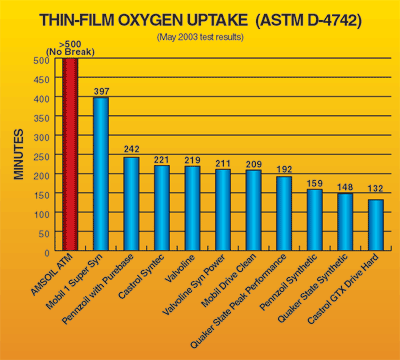 The
Thin-Film Oxygen Uptake Test evaluates the oxidation stability of lubricating
oils. A mixture of the test oil and chemistries found in gasoline engine
operation (oxidized/nitrated fuel, soluble metals and distilled water) are
placed in a test vessel, which is pressurized with oxygen and placed in a heated
bath. Anti-oxidant breakdown is evident when the oxygen pressure in the vessel
rapidly decreases. At this point, the induction time (break point) of the oil is
recorded.
The
Thin-Film Oxygen Uptake Test evaluates the oxidation stability of lubricating
oils. A mixture of the test oil and chemistries found in gasoline engine
operation (oxidized/nitrated fuel, soluble metals and distilled water) are
placed in a test vessel, which is pressurized with oxygen and placed in a heated
bath. Anti-oxidant breakdown is evident when the oxygen pressure in the vessel
rapidly decreases. At this point, the induction time (break point) of the oil is
recorded.
As shown in the graph, AMSOIL Synthetic 10W-30 Motor Oil had the highest induction time of all the tested oils. In fact, it didn't reach its break point in over 500 minutes of testing (over 8 hours).
The superior oxidation stability of AMSOIL Synthetic 10W-30 Motor Oil allows it to effectively resist the formation of engine deposits and sludge, keeping engines running clean and efficient and extending oil life. It also resists thickening, maintaining its superior wear protection and lubricating properties and maximizing fuel efficiency.
High Temperature/High Shear (ASTM D-4683)
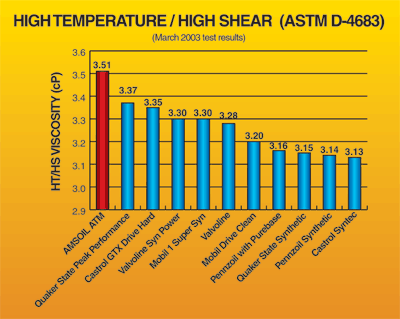 The
High Temperature/High Shear Test measures a lubricant's viscosity under severe
high temperature and shear conditions that resemble highly-loaded journal
bearings in fired internal combustion engines. In order to prevent bearing wear,
it is important for a lubricant to maintain its protective viscosity under
severe operating conditions. The minimum High Temperature/High Shear viscosity
for a 30 weight oil is 2.9 cP.
The
High Temperature/High Shear Test measures a lubricant's viscosity under severe
high temperature and shear conditions that resemble highly-loaded journal
bearings in fired internal combustion engines. In order to prevent bearing wear,
it is important for a lubricant to maintain its protective viscosity under
severe operating conditions. The minimum High Temperature/High Shear viscosity
for a 30 weight oil is 2.9 cP.
As shown in the graph, AMSOIL Synthetic 10W-30
Motor Oil surpasses this minimum standard and displayed the highest High
Temperature/High Shear viscosity in the group.
The superior viscosity retention of AMSOIL Synthetic 10W-30 Motor Oil in the face of severe temperature and shear conditions allows it to provide continuous, unsurpassed protection for engine bearings, extending equipment life and preventing wear.
NOACK Volatility (ASTM D-5800)
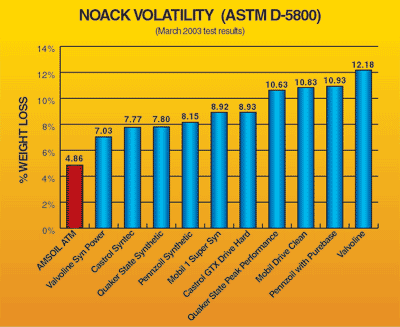 The
NOACK Volatility Test determines the evaporation loss of lubricants in high
temperature service. The more motor oils vaporize, the thicker and heavier they
become, contributing to poor circulation, reduced fuel economy and increased oil
consumption, wear and emissions. A maximum of 15 percent evaporation loss is
allowable to meet API SL and ILSAC GF-3 specifications.
The
NOACK Volatility Test determines the evaporation loss of lubricants in high
temperature service. The more motor oils vaporize, the thicker and heavier they
become, contributing to poor circulation, reduced fuel economy and increased oil
consumption, wear and emissions. A maximum of 15 percent evaporation loss is
allowable to meet API SL and ILSAC GF-3 specifications.
As shown in the graph,
AMSOIL 10W-30 Synthetic Motor Oil outperformed its nearest competitor by over 30
percent.
The extremely low volatility of AMSOIL Synthetic 10W-30 Motor Oil allows it to maintain its superior protective and performance qualities throughout extended drain intervals, even when faced with severe operating temperatures. In addition, oil consumption and emissions are minimized and fuel efficiency is maximized.
Pour Point (ASTM D-97)
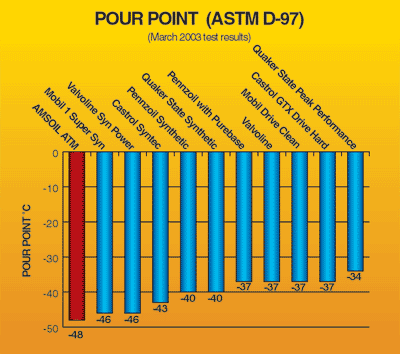 The
Pour Point Test determines the lowest temperature at which a lubricant will flow
when cooled under prescribed conditions. The lower a lubricant's pour point, the
better protection it provides in low temperature service. As shown in the graph,
AMSOIL Synthetic 10W-30 Motor Oil has the lowest pour point of the tested oils.
The
Pour Point Test determines the lowest temperature at which a lubricant will flow
when cooled under prescribed conditions. The lower a lubricant's pour point, the
better protection it provides in low temperature service. As shown in the graph,
AMSOIL Synthetic 10W-30 Motor Oil has the lowest pour point of the tested oils.
The low pour point of AMSOIL 10W-30 Synthetic Motor Oil allows it to maintain
its fluidity in extremely low temperatures, reducing drag on moving vehicle
parts, providing critical engine components with quick, essential lubrication
and easing startup in cold temperatures. Wear is greatly reduced and equipment
life is extended.
Total Base Number (ASTM D-2896)
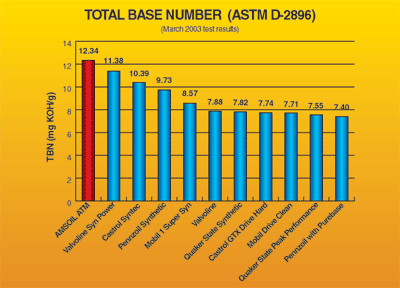 Total
Base Number (TBN) is the measurement of a lubricant's reserve alkalinity, which
aids in the control of acids formed during the combustion process. The higher a
motor oil's TBN, the more effective it is in suspending wear-causing
contaminants and reducing the corrosive effects of acids over an extended period
of time.
Total
Base Number (TBN) is the measurement of a lubricant's reserve alkalinity, which
aids in the control of acids formed during the combustion process. The higher a
motor oil's TBN, the more effective it is in suspending wear-causing
contaminants and reducing the corrosive effects of acids over an extended period
of time.
As shown in the graph, AMSOIL Synthetic 10W-30 Motor Oil has the highest TBN of the tested
oils.
The high TBN of AMSOIL Synthetic 10W-30 Motor Oil allows it to effectively combat wear-causing contaminants and acids, providing superior protection and performance over extended drain intervals.
Cold Crank Simulator (ASTM D-5293)
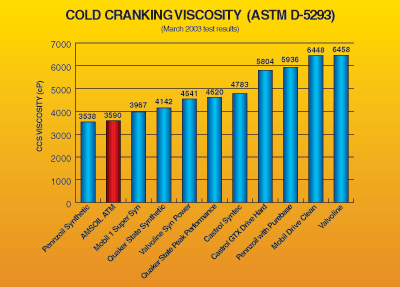 The
Cold Crank Simulator Test determines the apparent viscosity of lubricants at low
temperatures and high shear rates. Viscosity of lubricants under these
conditions is directly related to engine cranking and startability. The lower a
lubricant's cold crank viscosity, the easier an engine will turn over in cold
temperatures. 10W motor oils are tested at -25įC and must have a viscosity
below 7000 cP to pass.
The
Cold Crank Simulator Test determines the apparent viscosity of lubricants at low
temperatures and high shear rates. Viscosity of lubricants under these
conditions is directly related to engine cranking and startability. The lower a
lubricant's cold crank viscosity, the easier an engine will turn over in cold
temperatures. 10W motor oils are tested at -25įC and must have a viscosity
below 7000 cP to pass.
As shown in the graph, AMSOIL Synthetic 10W-30 Motor Oil
is well below the maximum requirement, while many of the competing oils barely
pass.
The low cold crank viscosity of AMSOIL Synthetic 10W-30 Motor Oil reduces
drag on moving engine parts and allows engines to achieve critical cranking
speed in extremely frigid temperatures. Engines turn over quickly and dependably
in the coldest winter temperatures.
Four Ball Wear (ASTM D-4172)
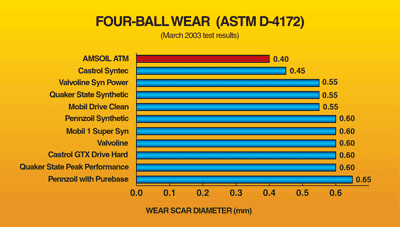 The
Four Ball Wear Test determines the wear protection properties of a lubricant.
Three metal balls are clamped together and covered with the test lubricant,
while a rotating fourth ball is pressed against them in sliding contact. This
contact typically produces a wear scar, which is measured and recorded. The
smaller the average wear scar, the better the wear protection provided by the
lubricant.
The
Four Ball Wear Test determines the wear protection properties of a lubricant.
Three metal balls are clamped together and covered with the test lubricant,
while a rotating fourth ball is pressed against them in sliding contact. This
contact typically produces a wear scar, which is measured and recorded. The
smaller the average wear scar, the better the wear protection provided by the
lubricant.
As shown in the graph, AMSOIL Synthetic 10W-30 Motor Oil produced the
smallest wear scar of the tested lubricants.
AMSOIL Synthetic 10W-30 Motor Oil provides unsurpassed protection against engine wear. Equipment life is extended, and repairs, downtime and expenses are reduced.
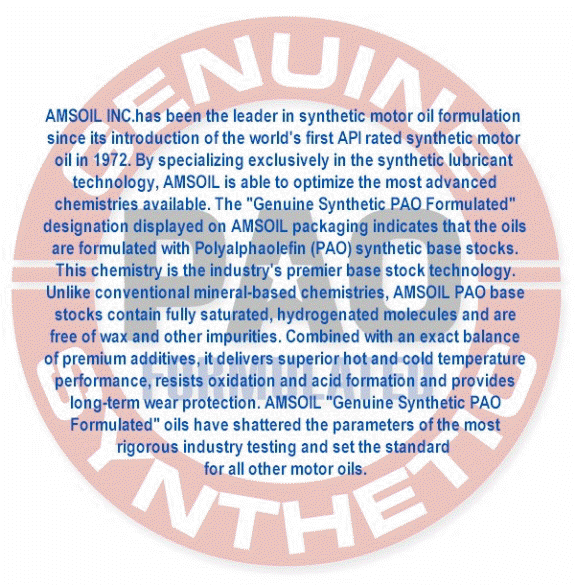
They Say Nothing
Outperforms Mobil 1? Wrong!
AMSOIL INC. set out to examine the specifics of the overly broad
"Nothing Outperforms..." Mobil claim.
AMSOIL 5W-30 Synthetic Motor Oil (ASL) and Mobil 1 SuperSyn 5W-30 Motor Oil were
analyzed in five key bench tests measuring motor oil performance: NOACK
volatility, flash/fire point, pour point, four ball wear and total base number (TBN).
As shown in the charts below,
AMSOIL outperformed Mobil 1 in all five areas.
 The
NOACK Volatility Test determines the evaporation loss of lubricants in
high-temperature service. The more motor oils vaporize, the thicker and heavier
they become, contributing to poor circulation, reduced fuel economy, increased
oil consumption and excessive wear and emissions. A maximum of 15 percent
evaporation loss is allowable to meet the API SL and ILSAC GF-3 specifications.
As shown in the graph, AMSOIL 5W-30 Synthetic Motor Oil lost an extremely low
4.9 percent of its original weight during high-temperature service, maintaining
its superior protective and performance qualities,while Mobil 1 SuperSyn 5W-30
Motor Oil lost 9.17 percent of its original weight.
The
NOACK Volatility Test determines the evaporation loss of lubricants in
high-temperature service. The more motor oils vaporize, the thicker and heavier
they become, contributing to poor circulation, reduced fuel economy, increased
oil consumption and excessive wear and emissions. A maximum of 15 percent
evaporation loss is allowable to meet the API SL and ILSAC GF-3 specifications.
As shown in the graph, AMSOIL 5W-30 Synthetic Motor Oil lost an extremely low
4.9 percent of its original weight during high-temperature service, maintaining
its superior protective and performance qualities,while Mobil 1 SuperSyn 5W-30
Motor Oil lost 9.17 percent of its original weight.
 The
Four Ball Wear Test determines the wear protection properties of a lubricant by
measuring the wear scars produced by four metal balls in sliding contact under
the test parameters. The smaller the average wear scar, the better the wear
protection provided by the lubricant. As shown in the graph, AMSOIL 5W-30
Synthetic Motor Oil completed the Four Ball Wear Test producing a smaller wear
scar than the Mobil 1 SuperSyn 5W-30 Motor Oil.
The
Four Ball Wear Test determines the wear protection properties of a lubricant by
measuring the wear scars produced by four metal balls in sliding contact under
the test parameters. The smaller the average wear scar, the better the wear
protection provided by the lubricant. As shown in the graph, AMSOIL 5W-30
Synthetic Motor Oil completed the Four Ball Wear Test producing a smaller wear
scar than the Mobil 1 SuperSyn 5W-30 Motor Oil.
 The
Flash/Fire Point Test determines the lowest temperatures at which application of
a flame will cause lubricant vapors to ignite (flash point) and sustain burning
for five seconds (fire point). Lubricants with higher flash and fire points
exhibit more stable volatility characteristics and are safer to use and
transport. As shown in the graph, AMSOIL 5W-30 Synthetic Motor Oil has higher
flash and fire points than does Mobil 1 SuperSyn 5W-30 Motor Oil.
The
Flash/Fire Point Test determines the lowest temperatures at which application of
a flame will cause lubricant vapors to ignite (flash point) and sustain burning
for five seconds (fire point). Lubricants with higher flash and fire points
exhibit more stable volatility characteristics and are safer to use and
transport. As shown in the graph, AMSOIL 5W-30 Synthetic Motor Oil has higher
flash and fire points than does Mobil 1 SuperSyn 5W-30 Motor Oil.
 The
Pour Point Test determines the lowest temperature at which a lubricant flows.The
lower a lubricantís pour point,the better protection it provides in
low-temperature service.As shown in the graph, AMSOIL 5W-30 Synthetic Motor Oil
has a lower pour point than Mobil 1 SuperSyn 5W-30 Motor Oil.
The
Pour Point Test determines the lowest temperature at which a lubricant flows.The
lower a lubricantís pour point,the better protection it provides in
low-temperature service.As shown in the graph, AMSOIL 5W-30 Synthetic Motor Oil
has a lower pour point than Mobil 1 SuperSyn 5W-30 Motor Oil.
 Total
Base Number (TBN) is the measurement of a lubricantís reserve alkalinity. The
higher a motor oilís TBN, the more effective it is in handling contaminants
and reducing the corrosive effects of acids for an extended period of time. As
shown in the graph, AMSOIL 5W-30 Synthetic Motor Oil has a higher TBN than Mobil
1 SuperSyn 5W-30 Motor Oil.
Total
Base Number (TBN) is the measurement of a lubricantís reserve alkalinity. The
higher a motor oilís TBN, the more effective it is in handling contaminants
and reducing the corrosive effects of acids for an extended period of time. As
shown in the graph, AMSOIL 5W-30 Synthetic Motor Oil has a higher TBN than Mobil
1 SuperSyn 5W-30 Motor Oil.
I think that settles that !
Maybe you need more convincing?
Amsoil motorcycle oil vs Eleven other major oils.
These tests put Amsoil up against eleven other
oils.
Tested were: Mobil, Golden Spectro, Harley Davidson,
Royal Purple,
Motul, Castrol (2 types), BMW, Valvoline, Yamalube & Belray.
As usual, Amsoil beat the competition!
20W-50 Motorcycle Oil
High Temperature Viscosity Protection
Higher values reflect better
film strength
ASTM Test Method D-4683 March 16, 2005

___________________________________________________________________________
20W-50 Motorcycle Oil
Wear Comparison
The smaller the wear scar the better
ASTM Test Method D-4683 March 16, 2005

7,500 mile EXTENDED DRAIN STUDY
3000 mile oil change vs Amsoil 7500 mile oil change - plus more.
AMSOIL XL-7500 Synthetic Motor Oils gave 12,000 miles service with excellent wear control and fluid integrity, showing 7,500-mile intervals are a piece of cake for these oils.
AMSOIL, Inc. and Lake Superior College of Duluth, Minnesota conducted a six-month study comparing the wear protection of AMSOIL XL-7500 Synthetic Motor Oil used for extended drain intervals to the wear protection of conventional motor oils used for conventional drain intervals. A report was issued on December 8, 1998 showing that AMSOIL XL-500 Synthetic Motor Oils used at extended drain intervals (7500 to 12,000 miles) provide better wear protection than conventional oils do at conventional (3000 miles) drain intervals.
Protocol
Six automobiles belonging to students were selected for the study. All were 1994 models or newer with starting mileage between 10,000 and 75,000. Each had 2,800 to 3,200 miles of use since the last motor oil change. Each was operated an average of 750 miles a week. The control group contained three vehicles using conventional petroleum motor oils changed at 3,000-mile intervals. The test group contained three vehicles using AMSOIL XL-7500 Synthetic Motor Oil changed at 7,500-mile intervals.
Baselines were established for each vehicle using a standardized protocol, including evaluation of used oil condition. After establishing baselines, the oil and oil filter of each vehicle were replaced and each vehicle was provided with two quarts of make-up oil of the brand and viscosity grade installed in the engine.
Vehicle owners were instructed to have preventive and general maintenance performed on the vehicles as needed, with the exception of oil and filter changes, which are done at intervals prescribed by the study and performed by study personnel. Oil samples were also taken from all vehicles at 3,000-, 6,000- and 9,000-mile intervals, and one was taken from the test vehicles at the 7,500-mile interval. Two of the test vehicles continued using the AMSOIL product for a total of 12,000 miles each.
Method
The rate of internal engine wear was evaluated through spectrochemical analyses of used oil, as determined by levels of iron, aluminum, lead and copper, using the ASTM D5185 test method. Samples were also evaluated for viscosity (ASTM D445) and Total Base Number (ASTM 2896). Oxidation/nitration changes and the presence of concentration of water, glycol, fuel, solids and additional elements were monitored
Results
Measures of iron, aluminum and lead showed lower wear rates in the vehicles using AMSOIL XL-7500 Synthetic Motor Oils for extended drains than in vehicles using conventional oils for 3,000-mile drain intervals, with rates as much as 80.9% lower (iron) for the AMSOIL lubricated vehicles.
The overall viscosity change for the control vehicles was a 15.41% increase. The overall change for the AMSOIL vehicles was a 7.38% increase, less than half that of the conventional oil.
The conventional oil lost an average of 68.3% TBN, while the extended drain AMSOIL group lost an average 36.1% TBN than the control group did, though the AMSOIL-equipped vehicles used extended drain intervals while the conventionally-equipped vehicles did not.
The extended drain AMSOIL-equipped vehicles also generated 68.6% less (by volume) oxidation contaminants and 65.9% less (by volume) nitration contaminants than the conventionally equipped vehicles.
Discussion
"In general," the study concludes, "the data suggest the AMSOIL product is capable of providing service for a period beyond the 7,500-mile interval for which it was designed. Utilization of those intervals offers no compromise in the areas reviewed in this evaluation."
In fact, with drain intervals up to 12,000 miles, AMSOIL XL-7500 Synthetic Motor Oil provided less wear, less viscosity changes, less TBN depletion and suffered less contamination than conventional oils changed at 3,000-mile intervals! AMSOIL proved to be the better oil, even after four times the length of service!

This chart shows a combined Efficiently &
Capacity scale for various oil
filters including Amsoil, Mobil 1, Hard Driver, Hastings, Wix, Pure 1,
Purolator, Ac, Defense (Fram), Group 7, Fram, Napa Gold, Pro Tec (Wix).
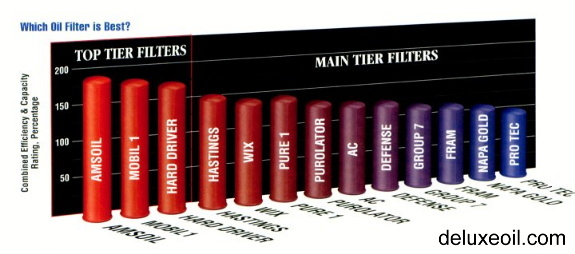
The following two charts show Efficiently &
Capacity separately.
It is important to have a combination of both, too fine of a filter or a
filter with lower contaminate capacity can plug up in a short time leaving
you
running with your bypass valve open and not filtering any oil and that's bad.
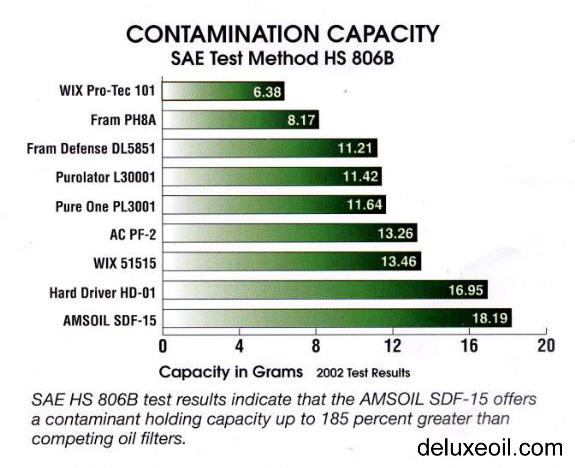
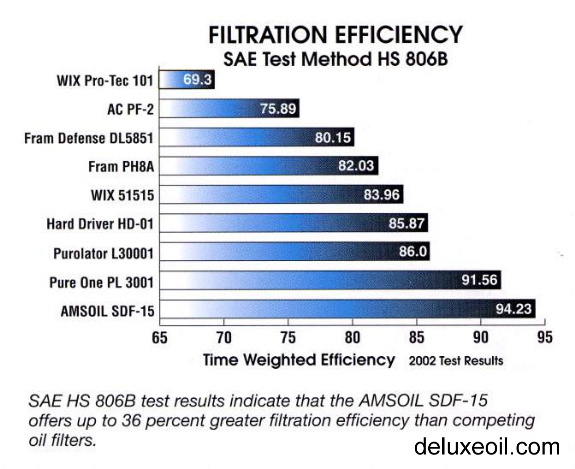
Places
to buy About
Amsoil 2
cycle oils Motor
oils Amsoil
tests
Extended Drain
Commercial - Retail
Amsoil Racing
Oil & Air Filters
Gear Oils


